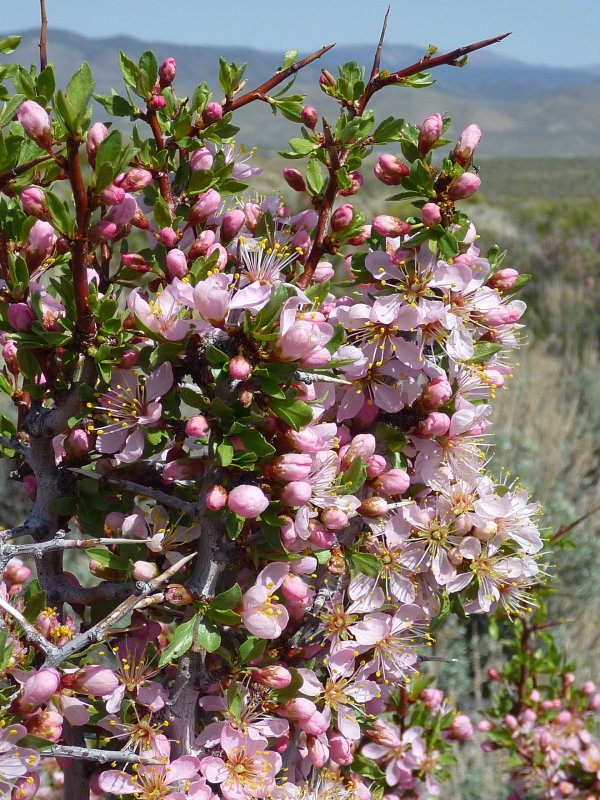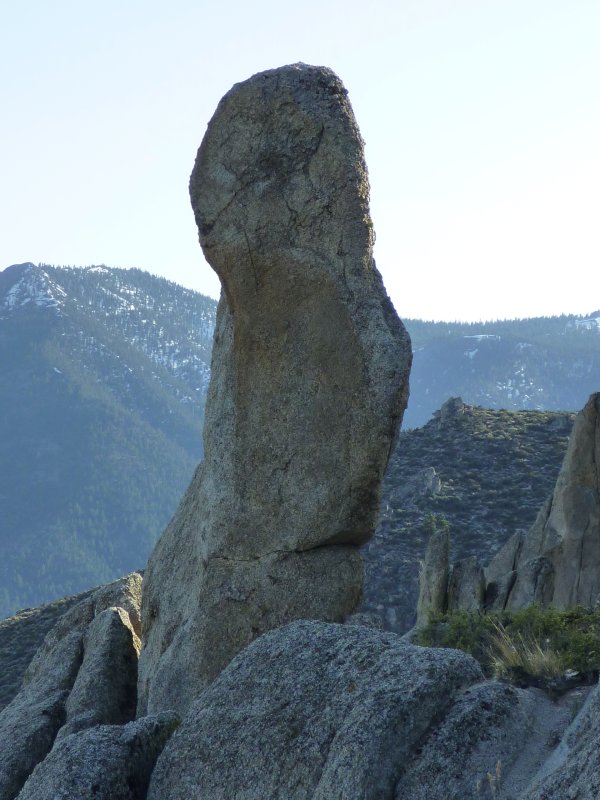
Blooming desert peach,
April 28, 2012
The Jack's Valley Habitat is located
south of Carson City between Highway 50 and Jack's Valley Road.
According to the wood board at its entrance less than half a mile
west of Jack's
Valley Elementary School “this area, about 3100 acres,
is reserved for management as winter deer range. About 700 acres
suffered a fire in 1986. This was reseeded in 1967 to a mixture
of plants for forage and ground cover fences were built in 1969
and 1970 to permit grazing under a rest rotation system designed
to benefit the deer range while harvesting forage for
cattle.”
This wildlife management area
(WMA) is particularly dedicated to
mule deer. Critical habitat has been
lost from wildfires and urban developement.
Mule deer herds migrate through
western North America and often try to find a range in which to
stay for a period of time, especially during winter months.
Maintainance of the Jack's Valley WMA helps to improve habitat
for mule deer along the Carson Front. Improvement work includes
removal of invading cheatgrass, seeding and reseeding of native
grasses and treatment of overgrown and crowded bitterbrush and
and sagebrush [1].
Many parts of the habitat consist of brush chaparall on sandy
soil. Desert peach is growing between sage and bitterbrush.
Besides seasonal mule deer populations, this
sagebrush ecosystem provides habitat
for coyotes, jack rabbits, quail and various other
animals including reptiles. The sagebrush provides food, cover
and shelter for these animals. Jack's Valley and its surrounding
hills and rock outcrops are visited by a variety of animals all
year round. An interpretive panel at the habitat entrance
explains the gathering and activities of migrating bird species
in this area:

Rock column up the sandy trail with
the Carson Range in the background
“Each summer, dozens of bird species migrate to the sagebrush
ecosystem in Jack's Valley WMA. Sage sparrow, Brewer's sparraw, and
sage thrasher are considered sagebrush obligates and require habitat
provided exclusively by the sagebrush ecosystem at some point in
their life. Other bird species, such as the black-billed magpie,
western meadowlark, loggerhead shrike, and sage grouse also use
this sagebrush ecosystem for breeding, shelter, or food. Red-tailed
hawks and golden eagles can often be seen soaring above the ground,
using thermal updrafts to carry them high above the land to search
for prey.”
The sagebrush ecosystem depends on periodic fires for plant
regeneration, propagation and nutrient cycling. Fires in this
area will not affect the rock outcrops through or over which
one may hike on the way up to open forest areas and vista points.
No thermal updrafts will take hikers to those places. One has to
climb upward over sand and gravel along steep slopes. The path of
the trail is neatly indicated by piles of rocks, kindly
assembled by previous hikers. At higher elevations visitors will
certainly enjoy the interesting rock formations, some covered with
colorful lichen and others, suprisingly, sustaining brush growth in
fissures and on top of them. The upper habitat sections offer
playgrounds for boulder hopping, quiet places for wildlife studies
and scenic views of the Carson Valley, River and Range.
Getting to and around in Jack's Valley Habitat
From Highway 395 in Sunridge south of Carson City drive west on
Jack's Valley Road. Find the WMA entrance and information
boards on the right side of this road, after about two miles
from its intersection with Highway 395.
The Humboldt-Toiyabe Nat'L Forest board informs that the area
is open to off-highway vehicle use (bikes and ATVs) from May to
October (approved spark arrestor/muffler and travel on designated
routes
required) and that it is closed for motorized traffic during the winter months from November 1 to April
30 (for additional information call 775-8822766).
To get to the rock
outcrops at higher elevation, follow the sand track northward for
less than one mile until you get to the small wood stage shown
in the picture. From here a single-track trail continues
through the chaparall to the natural rock sculptures and
further upward to the open pine forest.
Nearby trails and places of interest
|
Reference
|

